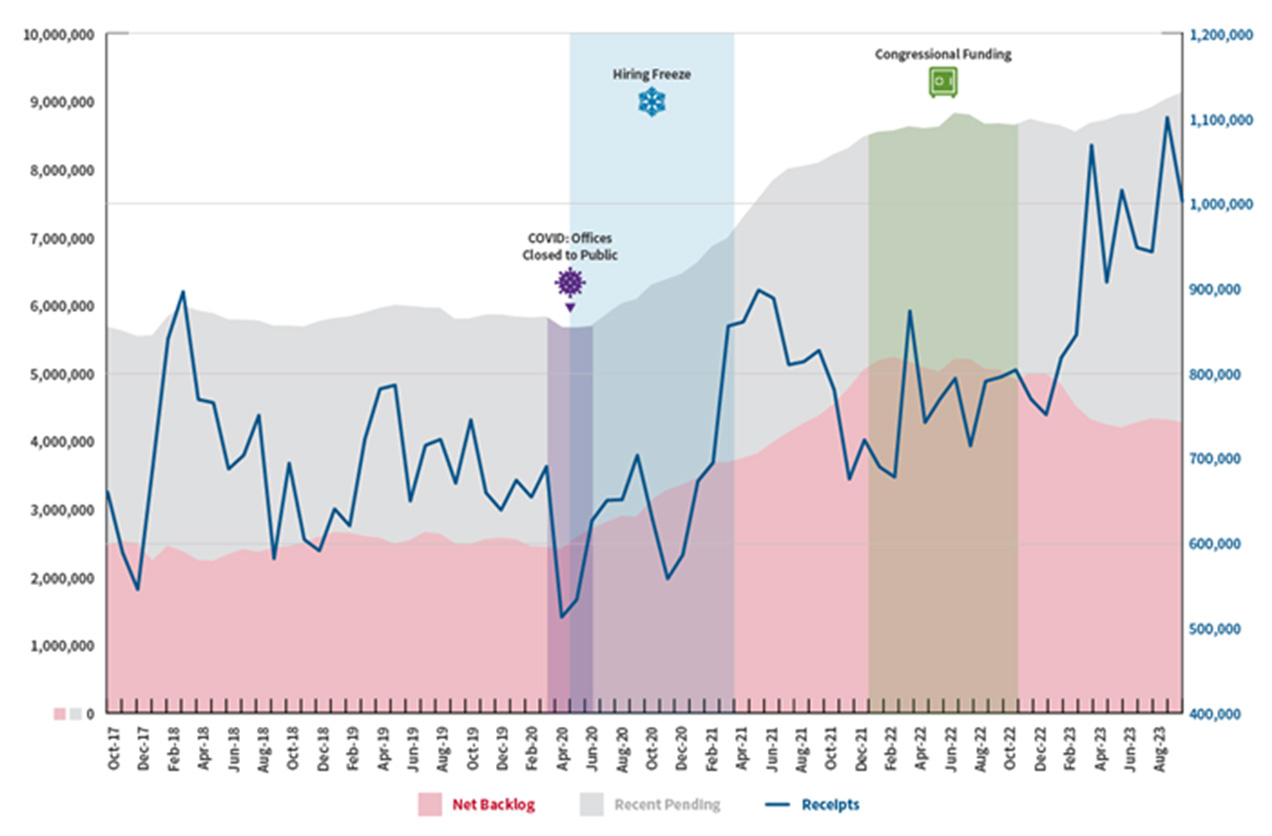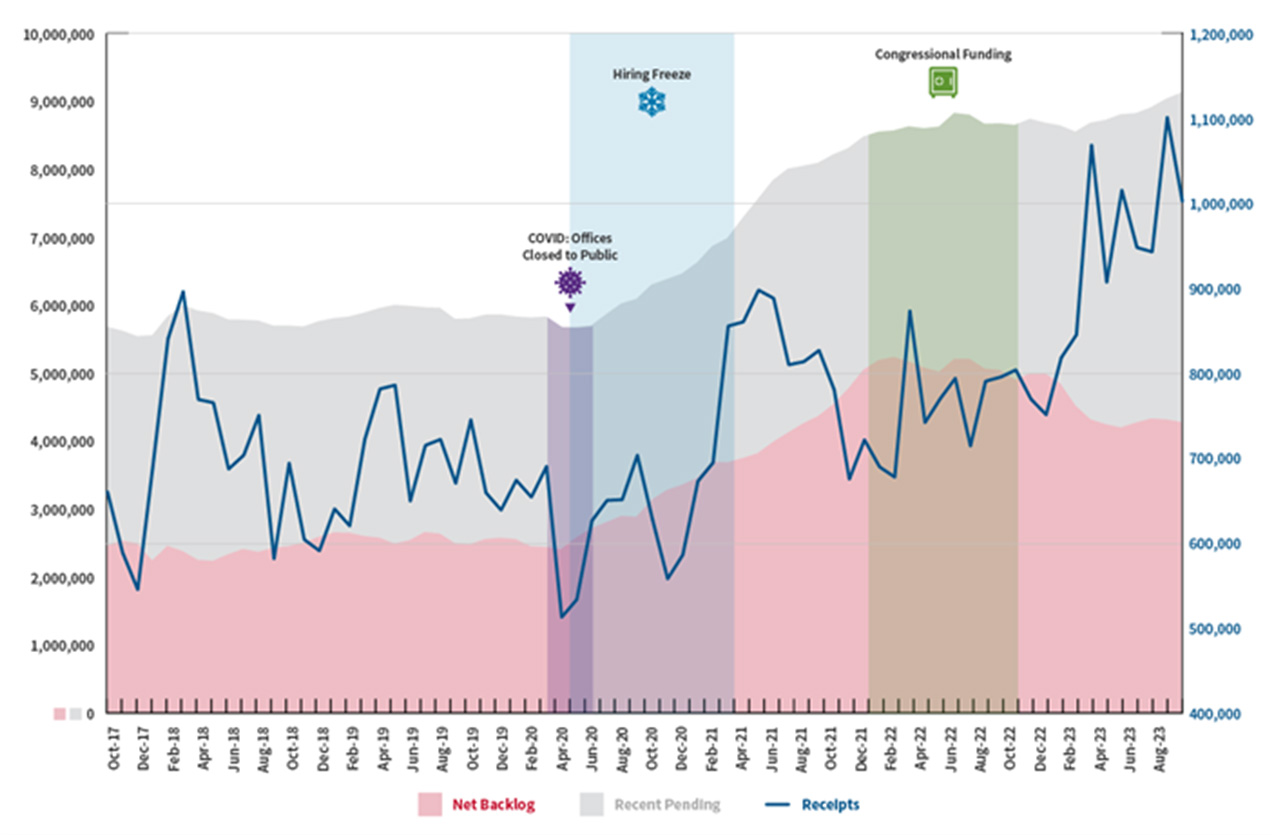New USCIS data show progress on customer experience, employment-based immigration, naturalization, and humanitarian work
WASHINGTON— Today U.S. Citizenship and Immigration Services (USCIS) is releasing end of fiscal year (FY) 2023 data that illustrate the agency’s progress in meeting its strategic priorities. The USCIS workforce has worked tirelessly over the past year to uphold America’s promise as a nation of welcome and possibility by reducing backlogs, improving customer experience, addressing humanitarian needs, and strengthening employment-based immigration.
“I’m so proud of the USCIS workforce and our dedication to fairness, integrity, and respect for all we serve,” said USCIS Director Ur M. Jaddou. “We’ve completed a record number of cases, responded to emerging crises around the globe with essential humanitarian relief, and applied innovative solutions to improve customer experience and reduce backlogs.”
Reducing Backlogs
In FY 2023, USCIS received 10.9 million filings and completed more than 10 million pending cases– both record-breaking numbers in the agency’s history. In doing so, USCIS reduced overall backlogs by 15%. Among USCIS’ record number of case completions in FY 2023, the agency administered the Oath of Allegiance to more than 878,500 new U.S. citizens, including 12,000 members of the military, effectively eliminating the backlog of naturalization applications . The median processing time for naturalization applicants decreased from 10.5 months to 6.1 months by the end of the fiscal year, achieving the agency’s longstanding goal and significantly reducing waiting times for most individuals seeking U.S. citizenship.
Improving Customer Experience
USCIS implemented several new technology solutions that meaningfully advance the customer experience for those navigating our immigration system. Our new self-service tool for online rescheduling of biometrics appointments was used to reschedule over 33,000 such appointments in FY 2023. Our new enterprise change of address capabilities enabled over 430,000 address changes to be submitted online through Dec. 2023. This tool is expected to reduce USCIS Contact Center phone inquiries by up to 31%, or approximately 1.5 million inquiries annually. From August to September 2023, USCIS received more than 16,000 field office appointment requests using our online request form, while a new text-ahead capability for callers to our 1-800 number gives them a more predictable call-back window and reduces missed calls.
Strengthening Immigration for Workers and Employers
In FY 2023, USCIS and the Department of State helped meet the needs of U.S. employers by issuing more than 192,000 employment-based immigrant visas – far above the pre-pandemic number – and, for the second year running ensured that no available visas went unused. The agency further supported U.S. employers and noncitizen workers in FY 2023 by increasing the maximum validity period of Employment Authorization Documents (EADs) to five years for adjustment of status applicants. We clarified eligibility for a range of immigration services, including the International Entrepreneur Rule, the EB-1 immigrant visa for individuals of extraordinary ability and outstanding professors and researchers, and the waiver of the two-year foreign residence requirement for J-1 cultural and educational exchange visitors (including foreign medical graduates). We proposed a new rule to strengthen worker protections and the integrity of the H-2 temporary worker program.
USCIS also removed the biometrics fee and appointment requirement for applicants for a change or extension of nonimmigrant status and updated the agency’s interpretation of the Child Status Protection Act to prevent many child beneficiaries of noncitizen workers from “aging out” of child status, allowing them to seek permanent residence along with their parents.
Fulfilling Our Humanitarian Mission
USCIS continues to address growing humanitarian needs around the globe, as individuals seek protection in the United States from oppression, violence, and other urgent circumstances. At a time when the world is experiencing the greatest displacement of people since World War II, our agency’s dedicated employees continue to advance our humanitarian mission and provide protection to vulnerable populations.
USCIS interviewed over 100,000 refugee applicants – more than double the amount completed in the previous fiscal year – resulting in the admission and resettlement of over 60,000 refugees. As of the end of FY 2023, USCIS completed more than 52,000 asylum cases; this included prioritizing process of asylum cases for Afghan alliance and their families. USCIS also completed a record-breaking 146,000 credible fear and reasonable fear screenings of individuals expressing a fear of return after being encountered at the border.
In FY 2023, USCIS continued to support Biden-Harris Administration efforts to establish lawful pathways that allow for the safe and orderly processing of individuals into the United States through the implementation of new processes for Cubans, Haitians, Nicaraguans, and Venezuelans (CHNV); the creation of new family reunification processes for individuals from Colombia, El Salvador, Guatemala, and Honduras, and the modernization of existing processes for Cuba and Haiti; and by maintaining support for the Uniting for Ukraine (U4U) process. As of the end of FY 2023, more than 150,000 Ukrainian nationals and their immediate family members had entered the United States under the U4U process and nearly 238,000 individuals through the CHNV process. USCIS is also a key partner in the Safe Mobility Office initiative, one of the many ways the United States is facilitating access to safe and lawful pathways in partner countries in Central and South America to prevent refugees and vulnerable migrants from undertaking dangerous journeys and discourage criminal smugglers who endanger the lives of vulnerable noncitizens. USCIS also announced enhancements to the Central American Minors Program, including expanding eligibility criteria for such children to qualify for access to the U.S. Refugee Admissions Program.
USCIS announced the creation of its sixth service center, the Humanitarian, Adjustment, Removing Conditions, and Travel Documents (HART) Service Center, which focuses on adjudicating benefits requests filed by vulnerable populations. USCIS made significant strides in recruiting, hiring, onboarding, and training new hires, growing the HART Service Center by almost 90% in FY23, and enhancing agency capabilities to adjudicate humanitarian and related cases.
Looking Ahead
In FY 2024, the agency is continuing to build on this progress while monitoring and addressing remaining processing delays. USCIS will work to maintain the median processing times of 30 days for certain EAD applications filed by individuals who entered the United States after scheduling an appointment through the CBP One mobile application or through the CHNV processes. The agency also proposed new rules to modernize and improve the efficiency and integrity of the H-1B program for specialty occupation workers. USCIS will work to maintain naturalization processing times and utilize all available employment-based visas.
As a fee-funded agency, USCIS achieved all these accomplishments within the constraints of a fee schedule that was last updated in 2016. We announced a new fee schedule that allows USCIS to more fully recover our operating costs, reestablish and maintain timely case processing, support the development and implementation of tools that further increase our efficiency and improve the customer experience, and help prevent the accumulation of future case backlogs. We continue to call on Congress to pass the Administration’s supplemental funding request, including additional resources for USCIS to cover projected shortfalls and hire additional personnel.
USCIS will continue to build capacity for processing historically high referrals for protection screenings at the southern border, while focusing remaining resources on the unprecedented number of pending affirmative asylum applications. USCIS will continue to increase refugee adjudications to support the target of admitting 125,000 refugees this fiscal year. USCIS also plans to increase refugee processing in the Western Hemisphere through the Safe Mobility Office initiative and is on track to admit between 35,000 and 50,000 refugees from the Western Hemisphere this fiscal year, the largest number from this region in history.
To enhance accessibility for those we serve, USCIS will also continue efforts to expand our international footprint outside the United States and remains committed to Operation Enduring Welcome for Afghan allies. USCIS will also invest additional resources to stand up the HART Service Center.
Finally, USCIS will implement new online filing tools to enhance the customer experience, including adding organizational accounts, launching online filing of H-1B petitions on Form I-129, Petition for a Nonimmigrant Worker, and adding an additional electronic intake channel for submission of forms and evidence in PDF format.
For more information on USCIS and our programs, please visit uscis.gov or follow us on Twitter (@uscis), Instagram (/uscis), YouTube (/uscis), and Facebook (/uscis).
As the federal agency that oversees lawful immigration to the United States, USCIS adjudicates a variety of immigration benefits and requests including naturalization, lawful permanent residency, employment visas, asylum, credible fear and foreign adoptions. By the end of FY 2023, the USCIS net backlog (cases pending outside of target processing times) was 4.3 million cases, down over 760,000 (15%) from more than 5 million cases at the end of FY 2022.
This progress occurred even as the agency experienced a record year in filings received – 10.9 million during FY 2023, compared with a more typical level of 9 million receipts in FY 2022 and FY 2021.
FY 2023 was the first year that USCIS successfully reduced the backlog in over a decade, following a spike that occurred after the onset of the COVID-19 pandemic. The backlog grew by 16% in FY 2022, which was slower growth than the two previous years – 43% in FY 2021 and 26% in FY 2020.
The slower backlog growth rate in FY 2022 and decline in FY 2023 were driven by ongoing efforts to increase hiring and an agency-wide drive to find new efficiencies in case processing. Congress also supported this effort with a crucial $275 million in appropriated funding in FY 2022 which continued to lead to positive impacts on the backlog. Additionally, in FY 2022, Congress also provided $193 million to support OAW, which helped alleviate the cost of unforeseen workloads associated with adjudicating immigration benefits for Afghan allies.
For a more detailed account of how the pandemic and a hiring freeze led to the doubling of the backlog, see our FY 2022 Progress Report (PDF, 1.08 MB). The chart below shows how the dedicated workforce at USCIS has begun turning the tide on our backlogs, even as case receipts rose significantly in FY 2023.
USCIS Pending Caseload and Receipts, FY 2018–FY 2023
Above: USCIS’ total pending caseload by month, consisting of net backlog (pending cases outside of target processing times) and recent pending (cases still within target processing times), along with case receipts by month.
In March 2022, USCIS established new internal cycle time goals for 25 forms to guide the agency’s backlog reduction efforts. A cycle time measures how many months’ worth of pending cases for a particular form are awaiting a decision and are used to gauge progress on reducing backlogs. As cycle times improve, processing times will follow, and applicants and petitioners will receive decisions on their cases more quickly.
USCIS increased capacity, improved technology, and expanded staffing to achieve these new cycle time goals by the end of FY 2023. The following table shows the goals for each form, alongside actual cycle times. By the end of FY 2023, USCIS achieved the cycle time goal for nine of these forms, including naturalization, and reduced cycle times for all but one of the 25 forms identified in March 2022. We achieved these across-the-board cycle time reductions at the same time we received a record number of new cases and responded to growing humanitarian needs.
In FY 2024, USCIS will continue our work to achieve these cycle time goals.
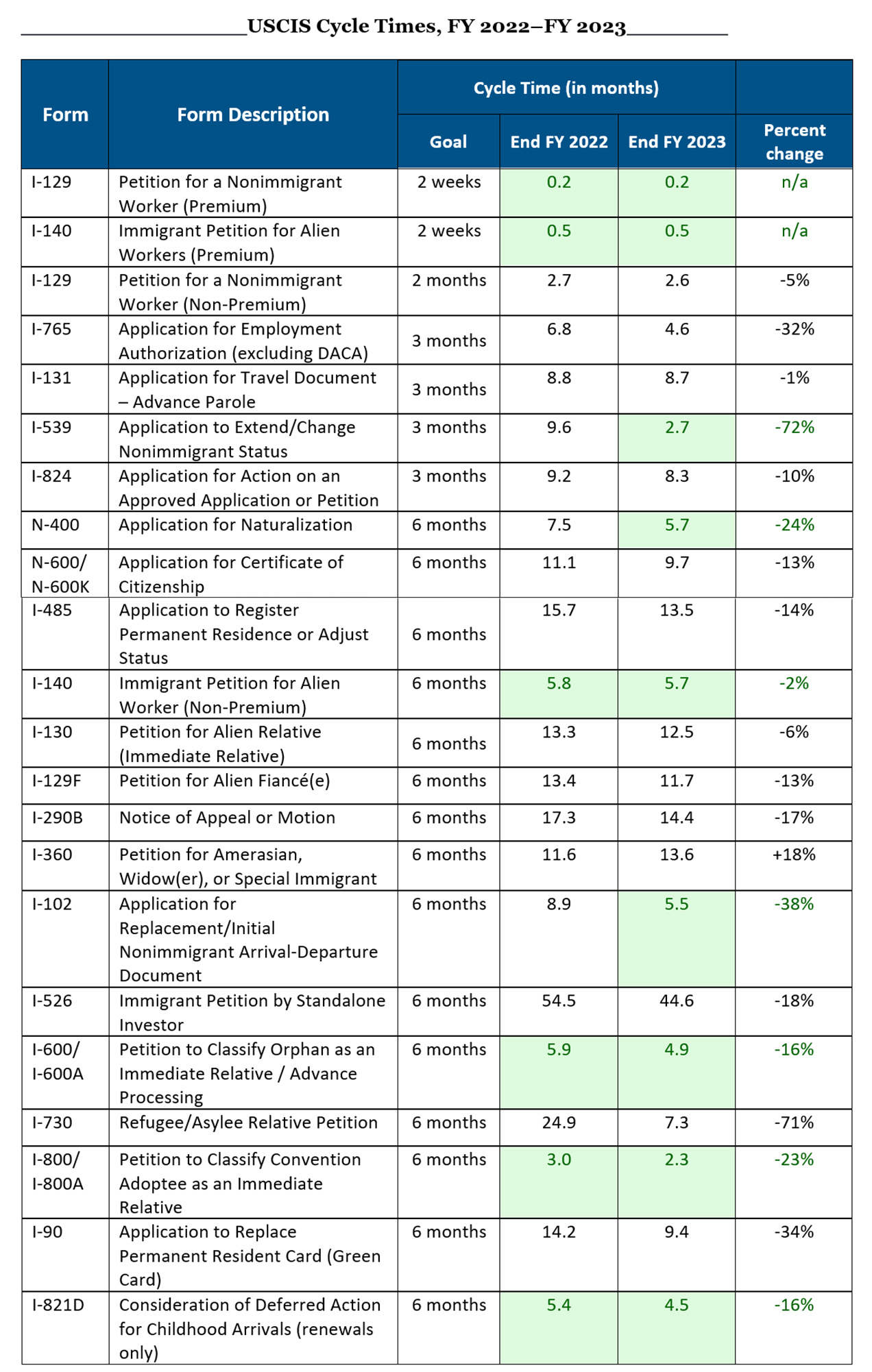
Above: Internally, USCIS monitors the number of pending cases in the agency’s workload through a metric called “cycle times.” A cycle time measures how many months’ worth of pending cases for a particular form are awaiting a decision. As an internal management metric, cycle times are generally comparable to the agency’s publicly posted median processing times, which in turn show the time it took USCIS to process a particular form – from when the agency received the application until a decision was made on the case. Green cells indicate that the actual cycle time was shorter than the agency’s publicly stated goal.
In FY 2022 (PDF, 1.08 MB), USCIS completed over 1 million applications for naturalization, welcoming the highest number of naturalized citizens in almost 15 years and reducing the net backlog by 62%.
Continuing these positive trends in FY 2023, USCIS completed 975,800 naturalization applications, administered the Oath of Allegiance to over 878,500 individuals, including 12,000 U.S. military service members, and nearly eliminated the net backlog. Factoring in individuals who derive citizenship from their parents, USCIS completed 1,045,600 naturalization cases. The median processing time for naturalization applicants decreased from 10.5 months to 6.1 months by the end of the fiscal year, achieving the agency’s longstanding processing time goal for most individuals seeking U.S. citizenship.
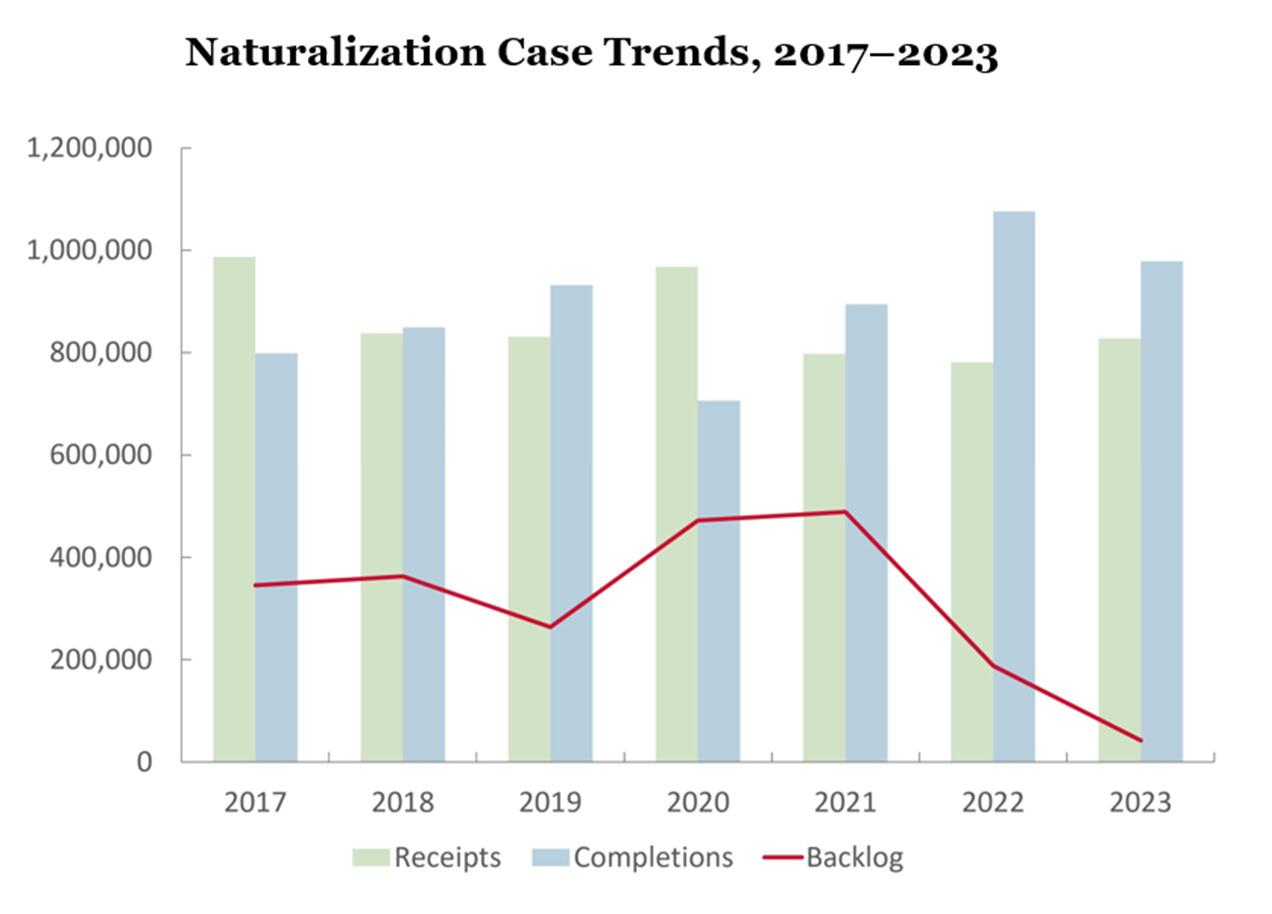
Above: In FY 2023, USCIS completed 975,800 naturalization applications (Form N-400) and administered the Oath of Allegiance for 878,500 new U.S. citizens. Including derivatives (Forms N-400, N-600, N-600K), USCIS completed 1,045,600 naturalization cases and administered the Oath of Allegiance to 883,900 new U.S. citizens.
In FY 2024
- USCIS will publish a new proposed rule to update regulations governing citizenship and naturalization, including updating adoption-related regulatory provisions consistent with the Intercountry Adoption Universal Accreditation Act of 2012.
- USCIS will release an updated and improved application for naturalization (Form N-400).
In FY 2023, USCIS implemented several new customer experience enhancements for those navigating our immigration system, including the following:
- Online Biometrics Rescheduling: USCIS launched a new self-service tool allowing noncitizens, along with their attorneys and accredited representatives, to reschedule most biometric services appointments before the date of the appointment, and without having to call our Contact Center. In FY 2023, we rescheduled over 33,000 biometric services appointments using the tool, with nearly one third of eligible customers choosing to reschedule online.
- myProgress Expansion: USCIS expanded myProgress (formerly known as personalized processing times) to Form I-765, Application for Employment Authorization; Form I-131 Application for Travel Document; Form I-821, Application for Temporary Protected Status; and Form I-485, Application to Register Permanent Residence or Adjust Status. This new tool delivers more accurate, personalized processing time estimates for those who choose to set up a myUSCIS account.
- Online Appointment Request Form: USCIS launched a new online process for individuals, attorneys, and accredited representatives to request an in-person appointment at their local field office without having to call our Contact Center. From the August launch through September, we received more than 16,000 appointment requests through this new online tool.
- Enterprise Change of Address: The new Enterprise Online Change of Address tool allows most customers to provide real-time address updates to USCIS online. This tool is expected to reduce USCIS Contact Center phone inquiries by up to 31%, or approximately 1.5 million inquiries annually. Since publicly releasing this tool in October 2023, over 430,000 address changes have been completed.
- Text-Ahead Feature: USCIS launched a text-ahead capability in English and Spanish for callers to our 1-800 number that gives them a more predictable call-back window and reduces the number of missed calls. This also provides an ease of reference for attorneys and accredited representatives with multiple cases.
- Expansion of Online Filing: USCIS continued its efforts to expand its online filing capabilities. In FY 2023, we added online filing for several forms:
- Form I-589, Application for Asylum and for Withholding of Removal (276,000 online filings, comprising 61% of the total).
- Form I-134, Declaration of Financial Support (164,000 online filings).
- Form I-134A, Request to be a Supporter and Declaration of Financial Support (1,960,000 filings, exclusively online).
- Form I-131, Application for Travel Document with certain exceptions (11,000 online filings).
- Form I-907, Request for Premium Processing Service, for concurrent filing with certain Forms I-765 and with certain Forms I-539.
- Form I-765, Application for Employment Authorization, expanded to asylum applicants (323,000 online filings; 30% of the total) and parolees (258,000 online filings; 62% of the total).
- Expansion of Premium Processing: USCIS expanded premium processing to include all petitions for immigrant workers (Form I-140), most employment authorization applications (Form I-765) for students and exchange visitors, and most changes of nonimmigrant status (Form I-539) to student categories.
- Self-Selection of Gender Markers: USCIS updated its guidance to clarify that it will accept the self-identified gender marker for individuals requesting immigration services.
Coming up in FY 2024
USCIS will continue to improve upon the work done in FY 2023 by implementing new tools that enhance the customer experience. In FY 2024, USCIS will deliver:
- Organizational Accounts and Online Filing of Form I-129 for H-1B: Ahead of the H-1B cap season, USCIS will release a new organizational myUSCIS account and an enhanced legal representative account. Both account types will have new features that allow petitioners and their representatives to share access to form drafts for collaboration on the H-1B registration and Form I-129 H-1B petition, as well as Form I-907 for premium processing, if applicable. Representatives will also be able to share access to form drafts with their paralegals and legal assistants for these form types.
- Expanding Electronic Intake Avenues: USCIS will implement an additional electronic intake channel for submission of certain applications, petitions, and benefit requests and their associated evidence in PDF format.
- Increasing Consistent and Proactive Communications: USCIS will employ an initial messaging capability that will allow USCIS to communicate key information, milestones, or updates directly with our customers instead of requiring them to reach out to the agency for updates. This tool will allow customers to set their communication frequency preferences.
In FY 2023, USCIS and the Department of State issued more than 192,000 employment-based immigrant visas – far above the pre-pandemic number – and ensured that no visas went unused for the second year running. (The FY 2023 employment-based annual limit was 197,091, plus 6,396 EB-5 visas that carried over from FY 2022 to FY 2023, and minus 10,874 EB-5 visas that Congress allowed to carry over from FY 2023 to FY 2024.)
USCIS further supported U.S. employers and noncitizen workers in FY 2023, with major policy and process improvements including:
- Increasing the maximum validity period of Employment Authorization Documents (EADs) to five years for adjustment of status applicants and bringing back “combo cards” that provide evidence of both employment authorization and advance parole.
- Proposing a new rule to strengthen worker protections and the integrity of the H-2 temporary worker programs, provide greater flexibility for H-2A and H-2B workers, and improve program efficiency.
- Removing the biometrics fee and appointment requirement for applicants for a change or extension of nonimmigrant status (Form I-539). When legally permitted or when resources and operational efficiency allow, USCIS may “bundle” the adjudication of derivative applications that are filed together with the associated petition. For example, USCIS is currently “bundling” forms I-129 and I-539 for certain classifications, which provides near-contemporaneous adjudication of the derivative form I-539 with the principal Form I-129.
- Publishing a comprehensive menu of options for noncitizen entrepreneurs to start and grow companies in the United States.
- Publishing resources for nonimmigrant workers following termination of employment to ensure that nonimmigrant workers who are laid off are aware of options that may permit them to remain in the country past the regular 60 day grace period.
- Updating the agency’s interpretation of the Child Status Protection Act to provide additional protection for child beneficiaries of noncitizen workers from “aging out” of child status and allowing them to seek permanent residence along status with their parents.
- Modernizing employment eligibility verification by allowing E-Verify employers to remotely examine Form I-9, Employment Eligibility Verification, documents starting Aug. 1, 2023, provided they follow certain steps.
- Updating policy guidance to clarify eligibility for a range of immigration benefits, including:
- The International Entrepreneur Rule, for startup founders demonstrating substantial potential for rapid growth and job creation.
- The EB-1 immigrant visa, for individuals of extraordinary ability and outstanding professors and researchers.
- The waiver of the two-year foreign residence requirement for J-1 cultural and educational exchange visitors, including foreign medical graduates.
- The “compelling circumstances” Employment Authorization Document, for certain nonimmigrants who are the beneficiaries of approved employment-based immigrant visa petitions, and who are caught in the lengthy immigrant visas backlog.
- The National Interest Waiver for physicians (PDF, 317.81 KB) working in an underserved area or at a U.S. Department of Veterans Affairs facility.
- The O-1B visa classification, for nonimmigrants of extraordinary ability in the arts and nonimmigrants of extraordinary achievement in the motion picture television industry.
In FY 2024
In FY 2024, USCIS is building on this progress by:
- Updating policy guidance for the EB-5 investor visa program, incorporating statutory reforms to the Regional Center Program as they relate to regional center designation and other requirements for immigrant investors.
- Updating policy guidance for student classifications, including eligibility for employment authorization, change of status, extension of stay, and reinstatement of status for F and M students and their dependents in the United States.
- Proposing a new rule to modernize and improve the efficiency and integrity of the H-1B program for specialty occupation workers.
- Proposing a new rule to modernize the adjustment of status process, including regulations clarifying the age calculation under the Child Status Protection Act, and the authorization of employment authorization for certain derivative beneficiaries awaiting immigrant visa availability when they present compelling circumstances.
USCIS continues to address the growing humanitarian needs of those seeking protection from oppression, violence, and other urgent circumstances. USCIS has seen significant growth in our humanitarian work (including asylum, Temporary Protected Status, and associated EAD applications. Over the last few years, these cases have gone from representing approximately 15% of all USCIS applications in FY 2015 to more than a quarter of new applications in FY 2023.
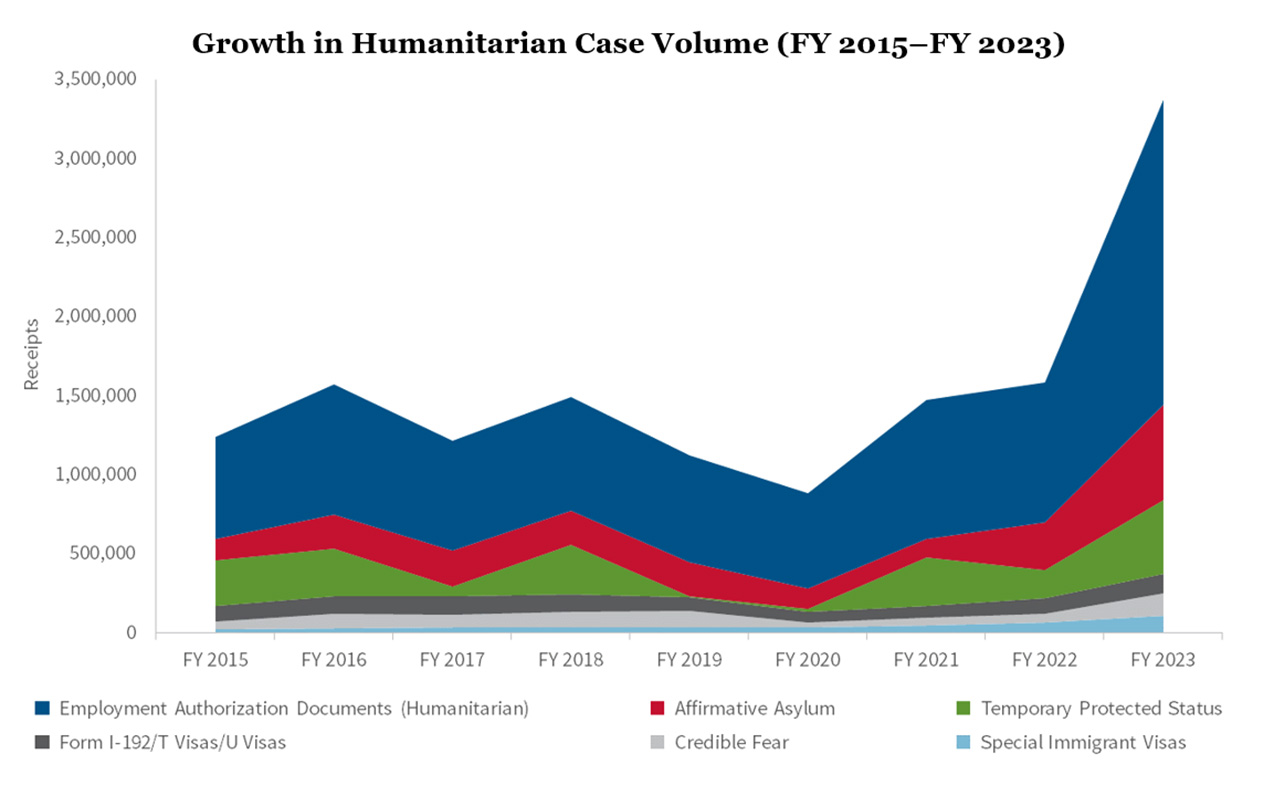
In FY 2023, USCIS continued to make progress on fulfilling these humanitarian imperatives by:
- Refugee Resettlement: Interviewing over 100,000 refugee applicants – more than double the previous fiscal year – contributing to the resettlement of over 60,000 refugees. Deploying officers to 76 countries and significantly reducing the overall processing time for refugee applicants, both by using remote processing and concurrent processing with U.S. Refugee Admissions Program (USRAP) partners.
- Safe Mobility Office Initiative: Working across the U.S. government and with international organization and regional partners to establish and operationalize Safe Mobility Offices (SMO) in Colombia, Costa Rica, and Guatemala to provide information and referrals to various lawful pathways. The SMO in Ecuador opened in early FY 2024. The Safe Mobility Office initiative established the SMOs and MovilidadSegura.org, which provide certain individuals with information and referrals to different lawful pathways to the United States.
- Support at the Southwest Border
- Completing more than 146,000 credible fear and reasonable fear screenings for noncitizens arriving at the southwest border who expressed a fear of persecution or torture.
- Establishing new capabilities to create and share electronic A-files across agencies at the Southwest Border, reducing the administrative burden on government personnel. This cut U.S. Customs and Border Protection (CBP) file creation time in half while saving on administrative and other related costs.
- Implementing call center capabilities that provide asylum officers a single contact point to connect with agents providing interpreter services in four primary languages: Spanish, Mandarin, Russian, and French.
- Promoting Safe and Orderly Migration
- Building on the success of Uniting for Ukraine, DHS developed processes to provide lawful pathways for certain nationals of Cuba, Haiti, Nicaragua, and Venezuela (CHNV), and confirmed the financial suitability of 298,144 CHNV supporters. As of the end of FY 2023, the following CHNV nationals and their immediate family members have entered the United States: 49,629 as part of the process for Cubans; 84,318 as part of the process for Haitians; 37,591 as part of the process for Nicaraguans; 66,401 as part of the process for Venezuelans.
- Implementing new family reunification parole processes for individuals from Colombia, El Salvador, Honduras, and Guatemala, and modernizing family reunification processes for Cuba and Haiti.
- Joining with the U.S. Department of State to announce enhancements to the CAM parole process and expand eligibility criteria for those who may request USRAP access for qualifying children.
- Operation Allies Welcome and Afghan Support Centers
- Extending fee exemptions and expediting application processing for certain Afghan nationals, as authorized and supported by multi-year Congressional funding.
- Creating a streamlined process for Afghan nationals who were paroled into the country between July 2021 and September 2023, to request consideration of a new period of parole, commonly referred to as re-parole.
- Hosting seven Afghan Support Centers in cities with large numbers of resettled Afghan nationals and providing assistance to over 5,000 individuals, an effort made possible through Congressional funding.
- Prioritizing processing of asylum cases for Afghan allies and their families
- Uniting for Ukraine: Providing significant support to the Uniting for Ukraine (U4U) process, including assessing the financial suitability of supporters for the U4U process. As of the end of FY 2023, more than 150,000 Ukrainian nationals and their immediate family members have entered he United States under the U4U process.
- Temporary Protected Status (TPS): Accepting TPS initial and re-registration applications under new designations, extensions, or redesignations for Afghanistan, Cameroon, El Salvador, Ethiopia, Haiti, Somalia, South Sudan, Sudan, Ukraine, and Yemen, and announcing redesignation for Venezuela. USICS also announced the extension of the re-registration periods from 60 days to 18 months for applicants under six TPS-designated countries: El Salvador, Haiti, Honduras, Nepal, Nicaragua, and Sudan.
- Hart Service Center: Opening the Humanitarian, Adjustment, Removing Conditions, and Travel Documents (HART) Service Center (PDF, 198.84 KB) [PDF], to adjudicate applications affecting some of the most vulnerable noncitizens.
- Statelessness: Assisting vulnerable stateless noncitizens, by announcing centralized USCIS resources to support consideration of noncitizens as stateless for immigration purposes.
In FY 2024
- USCIS will continue to increase refugee interviews and decisions to support the target of admitting 125,000 refugees this fiscal year including staying on track to admit between 35,000 and 50,000 refugees from the Latin American region in FY 2024.
- USCIS will continue to build capacity for processing credible fear screenings at the southwest border by focusing on hiring, retention, and training initiatives that cultivate an agile, highly qualified, and diverse workforce.
- USCIS will focus on technological and procedural improvements to streamline the adjudication of asylum applications. USCIS will continue to explore locations where USCIS may open additional international field offices as part of its international expansion efforts.
- On Oct. 1, 2023, USCIS began accelerating processing of EAD applications filed by individuals who arrived in the U.S. after parolees scheduling an appointment through CBP One and being granted parole. USCIS will continue to dedicate additional personnel and implement improvements to maintain the median processing time for EAD applications filed by those paroled after a CBP One appointment or were paroled through the CHNV parole processes at 30 days.
- USCIS will build on its nationwide campaign to provide timely information to individuals who are eligible to apply for an EAD. To date, nearly 2 million email and text notifications have been sent in English, Spanish, Haitian Creole, Ukrainian, and Russian, and USCIS is working extensively with cities to educate recently arrived migrants on the immigration system and how to apply for an EAD.
- USCIS will continue to implement the new family reunification process for Colombia, El Salvador, Honduras, and Guatemala as well as the modernized processes for Cuba and Haiti. In addition, on Nov. 15, 2023, USCIS announced the establishment of a new family reunification parole processes for certain individuals from Ecuador whose Form I-130, Petition for Alien Relative, filed on behalf of an Ecuadorian principal beneficiary has been approved.
- USCIS will continue its commitment to supporting our Afghan allies through Enduring Welcome.
- In FY 2024, USCIS will continue to build up the infrastructure and onboard and train new staff to adjudicate pending humanitarian and related cases at the HART Service Center.
Official news published at https://www.uscis.gov/EOY2023

